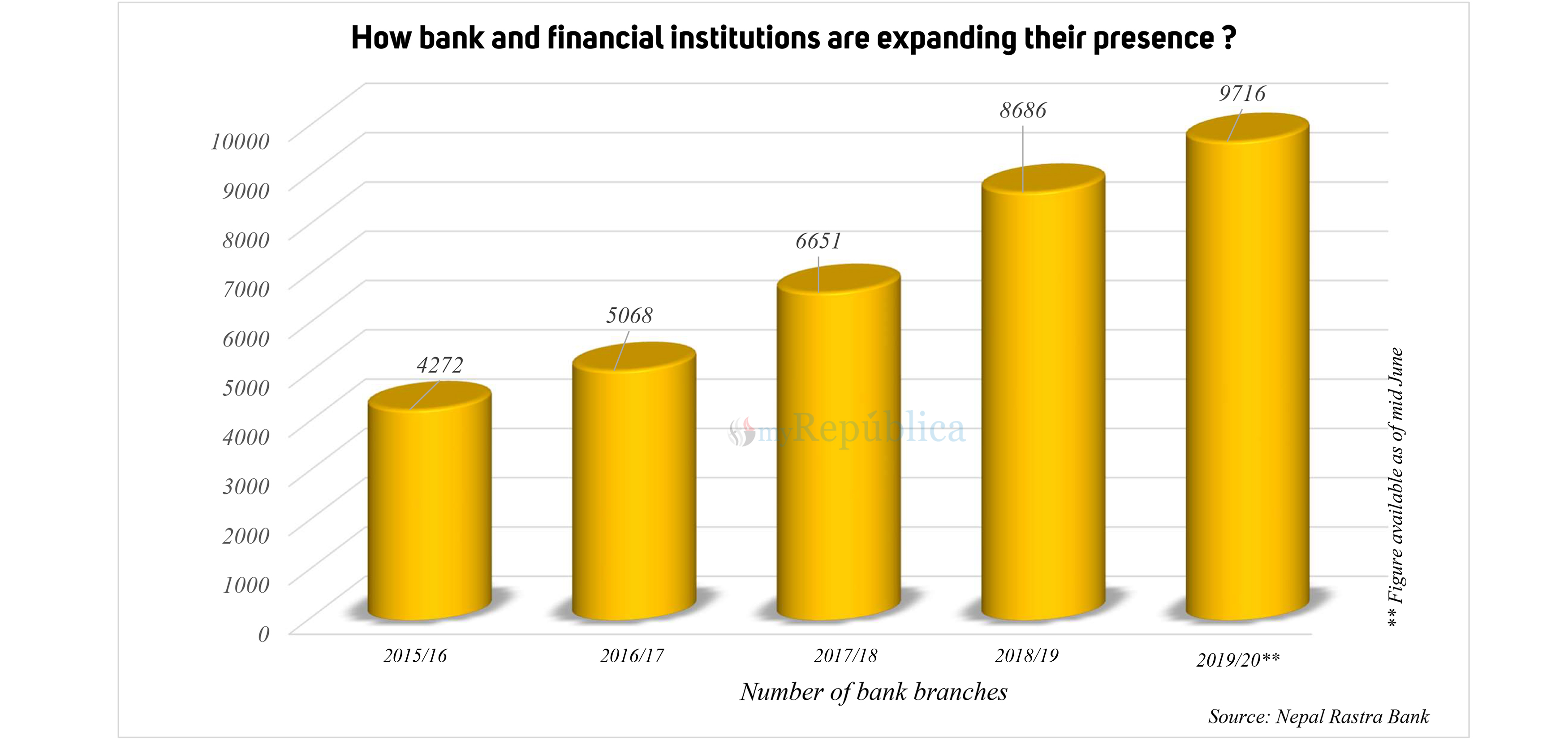
OR
BFIs opened 1,030 new branches in last fiscal year, thanks to banking sector’s aggressive expansion drive
Published On: August 9, 2020 11:46 AM NPT By: Republica | @RepublicaNepal

KATHMANDU, Aug 8: Banks and financial institutions (BFIs) have added 1,030 new branch offices across the country in 11 months of the last fiscal year 2019/20, reflecting an aggressive expansion drive of the banking industry to provide financial intermediary services.
According to Nepal Rastra Bank’s data, the total number of branches of BFIs rose to 9,716 in the first 11 months of last fiscal year 2019/20 [mid June of current year], up from 8,686 branches in the previous fiscal year 2018/19.
However, the rise in the number of branches is lower in the last fiscal year compared to 2,035 new branches that BFIs brought into operation in the previous fiscal year 2018/19 alone.
As of the end of fiscal year 2017/18, BFIs had a total of 6,651 branches across the country.
The total number represents all branches of ‘A’ class institutions licensed by the NRB and commonly known as commercial banks, ‘B’ class development banks, ‘C’ class finance companies and ‘D’ class microfinance institutions.
Bankers attribute the aggressive expansion drive to their desire to seek business opportunities in unbanked areas along with the regulatory push from the central bank to set up at least one bank branch in each local unit of the country.
“Our banking industry was under pressure to explore business opportunities by reaching out to new areas due to the growing competition in urban areas. Adding branches by one after another bank in the same area, they were all fighting for the same pie. Sooner or later, banks had to open their branches in the semi-urban as well as rural areas for sustainable business,” a commercial bank’s CEO told Republica.
“But, the central bank’s push in line with the government’s policy to have at least one bank branch in each local unit gave an impetus to the expansion plan of banks and financial institutions,” he added.
The government has a stated policy to have at least one branch of commercial banks in all 753 local units of the country. To help achieve the goal of the government policy, the NRB has not only put pressure on banks to set up branches in all local units but also offered incentives like interest-free loans for opening certain deposit accounts or opening branches in unbanked areas.
In line with a coordinated plan of 27 commercial banks, they have been opening their branches in all local units. This plan has fuelled the expansion drive, according to bankers. Commercial banks which had 3,585 branches in mid July last year increased their branch offices to 4,239 in mid June this year, the NRB data shows. However, the number of branch offices of development banks fell to 1,216 in mid June from 1,267 in the last year. Bankers say that the relocation and readjustment of branch offices in the wake of merger and acquisition of various banks has caused the decline. Many development banks have either pursued merger or acquisition in recent years as they struggle to meet the new capital requirement set by the central bank. Finance companies’ total branches increased to 239 in mid June from 205 in mid July last year. As new microfinance institutions started their operations in 2019, their branches also rose to 4,022 from 3, 6299, according to the NRB data.
However, NRB officials and bankers worry that COVID-19 and its impact on the economic activities could slam a brake on the expansion drive of the banking sector.
You May Like This

Boost investment in power transmission infrastructures
As Nepal strives to achieve uninterrupted power supply for all its citizens and capitalize on surplus electricity through exports, urgent... Read More...

Aug 21: 6 things to know by 6 PM
Your daily dose of missed important news of the day. ... Read More...

Nepal climbs two notches in World Bank’s doing business index
KATHMANDU, Nov 2: Nepal has inched up two notches in the latest ease of doing business index of the World Bank,... Read More...










Just In
- NRB introduces cautiously flexible measures to address ongoing slowdown in various economic sectors
- Forced Covid-19 cremations: is it too late for redemption?
- NRB to provide collateral-free loans to foreign employment seekers
- NEB to publish Grade 12 results next week
- Body handover begins; Relatives remain dissatisfied with insurance, compensation amount
- NC defers its plan to join Koshi govt
- NRB to review microfinance loan interest rate
- 134 dead in floods and landslides since onset of monsoon this year








Leave A Comment